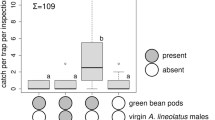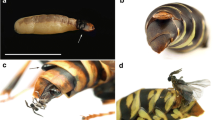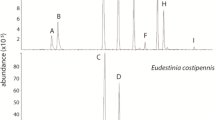Abstract
(S)-4-Methyl-3-heptanone is an alarm pheromone released from the mandibular glands in heads of harvester ants (Pogonomyrmex spp.). We used gas chromatography–mass spectrometry (GC–MS) to study the variation in amounts of this ketone among individual ants of a colony. P. barbatus contained about 2,000 ng per head, while only about half of this amount was found in heads of P. rugosus and P. californicus. Individuals of P. barbatus from three different nests contained rather uniform amounts of the alarm pheromone within each colony (16–30% coefficient of variation CV; normal distributions skewed left), but one nest under food stress had a significantly lower mean amount. In contrast, both sexes of a small braconid wasp Leiophron uniformis, a parasitoid of Lygus plant bugs, contained up to 10 ng of the same volatile enantiomer in their heads; and groups of either sex of the wasp exhibited normal distributions of quantities (64% CV, skewed right). The differences in the distributions between parasitoids and ants suggest that related members within a social ant colony may attempt to maintain a uniform level of ketone compared to independent variation in unrelated, solitary wasp individuals. When the wasp’s leg was grasped with forceps, it tried to escape and bite the forceps as it ejected (S)-4-methyl-3-heptanone (detected by solid phase microextraction, SPME, and GC–MS). Since adult wasps are nonsocial and feed only on nectar, their sharp piercing mandibles in combination with this escape/biting behavior indicate the ketone is used for defense rather than for an alarm function as in harvester ants. Costs of producing the semiochemical in wasp L. uniformis and ants P. barbatus and P. californicus are suggested since populations exhibited a significant linear increase in the amount of (S)-4-methyl-3-heptanone with an increase in body weight of individuals.




Similar content being viewed by others
References
Birgersson G, Schlyter F, Bergström G, Löfqvist J (1988) Individual variation in aggregation pheromone content of the bark beetle, Ips typographus. J Chem Ecol 14:1737–1761
Blackmer JL, Byers JA (2009) Lygus spp. (Heteroptera: Miridae) host-plant interactions with Lesquerella fendleri (Brassicaceae), a new crop in the arid southwest. Environ Entomol 38:159–167
Blackmer JL, Rodriquez-Saona C, Byers JA, Shope KL, Smith JP (2004) Behavioral response of Lygus hesperus to conspecifics and headspace volatiles of alfalfa in a Y-tube olfactometer. J Chem Ecol 30:1547–1564
Byers JA (1989) Chemical ecology of bark beetles. Experientia 45:271–283
Byers JA (2005) A cost of alarm pheromone production in cotton aphids, Aphis gossypii. Naturwissenschaften 92:69–72
Byers JA (2006a) Production and predator-induced release of volatile chemicals by the plant bug Lygus hesperus. J Chem Ecol 32:2205–2218
Byers JA (2006b) Pheromone component patterns of moth evolution revealed by computer analysis of the Pherolist. J Anim Ecol 75:399–407
Crewe RM, Blum MS (1972) Alarm pheromones of the Attini: their phylogenetic significance. J Insect Physiol 18:31–42
Debolt JW (1981) Laboratory biology and rearing of Leiophron uniformis (Gahan) (Hymenoptera: Braconidae), a parasite of Lygus species (Hemiptera: Miridae). Ann Entomol Soc Amer 74:334–337
Debolt JW (1982) Meridic diet for rearing successive generations of Lygus hesperus. Ann Entomol Soc Amer 75:119–122
Debolt JW (1989) Host preference and acceptance by Leiophron uniformis (Hymenoptera: Braconidae): Effects of rearing on alternate Lygus (Heteroptera: Miridae) species. Ann Entomol Soc Amer 82:399–402
Do Nascimento RR, Morgan ED, König WA, Della Lucia TMC (1997) Absolute configuration of 4-methyl-3-heptanone and 4-methyl-3-heptanol from mandibular glands of virgin males and females of Atta sexdens rubropilosa. J Chem Ecol 23:1569–1575
Fales HM, Blum MS, Crewe RM, Brand JM (1972) Alarm pheromones in the genus Manica derived from the mandibular gland. J Insect Physiol 18:1077–1088
Fye RE (1982) Weed hosts of the Lygus (Heteroptera: Miridae) complex in central Washington. J Econ Entomol 75:724–727
Goulet H, Mason PG (2006) Review of the nearctic species of Leiophron and Peristenus (Hymenoptera: Braconidae: Euphorinae) parasitizing Lygus (Hemiptera: Miridae: Mirini). Zootaxa 1323. Magnolia Press, Auckland
Graham HM, Jackson CG, Debolt JW (1986) Lygus spp (Hemiptera: Miridae) and their parasites in agricultural areas of southern Arizona. Environ Entomol 15:132–142
Hernández JV, Cabrera A, Jaffe K (1999) Mandibular gland secretion in different castes of the leaf-cutter ant Atta laevigata. J Chem Ecol 25:2433–2444
Hölldobler B, Oldham NJ, Morgan ED, König WA (1995) Recruitment pheromones in the ants Aphaenogaster albisetosus and A. cockerelli (Hymenoptera: Formicidae). J Insect Physiol 41:739–744
Hughes WOH, Howse PE, Goulson D (2001) Mandibular gland chemistry of grass-cutting ants: species, caste, and colony variation. J Chem Ecol 27:109–124
Ignoffo CM (1963) A successful technique for mass-rearing cabbage loopers on a semisynthetic diet. Ann Entomol Soc Am 56:178–182
Leigh TF, Kerby TA, Wynholds PF (1988) Cotton square damage by the plant bug, Lygus hesperus (Hemiptera: Heteroptera: Miridae), and abscission rates. J Econ Entomol 81:1328–1337
Loan CC (1974) The North American species of Leiophron Nees, 1818 and Peristenus Foerster, 1862 (Hymenoptera: Braconidae, Euphorinae) including the description of 31 new species. Nat Can 101:821–860
MacMahon JA, Mull JF, Crist TO (2000) Harvester ants (Pogonomyrmex spp.): their community and ecosystem influences. Ann Rev Ecol Syst 31:265–291
McGurk DJ, Frost J, Eisenbraun EJ, Vick K, Drew WA, Young J (1966) Volatile compounds in ants: identification of 4-methyl-3-heptanone from Pogonomyrmex ants. J Insect Physiol 12:1435–1441
Moser J, Brownlee RG, Silverstein RM (1968) The alarm pheromone of Atta texana (Buckley). J Insect Physiol 14:529–535
Oettler J, Johnson RA (2009) The old ladies of the seed harvester ant Pogonomyrmex rugosus: foraging performed by two groups of workers. J Insect Behav 22:217–226
Riley RG, Silverstein RM, Moser JC (1974) Isolation, identification, synthesis and biological activity of volatile compounds from the heads of Atta ants. J Insect Physiol 20:1629–1637
Roughgarden J (1979) Theory of population genetics and evolutionary ecology: an introduction. MacMillan, NY
Sappington TW, Taylor OR (1990) Developmental and environmental sources of pheromone variation in Colias eurytheme butterflies. J Chem Ecol 16:2771–2786
Schmidt JO (2003) Venom. In: Cardé RT, Resh VH (eds) Encyclopedia of insects. Elsevier Science, Academic Press, San Diego, pp 1160–1163
Schmidt JO, Blum MS (1978) A harvester ant venom: chemistry and pharmacology. Science 200:1064–1066
Scott DR (1977) An annotated listing of host plants of Lygus hesperus Knight. Bull Entomol Soc Amer 23:19–22
Smith RL (1986) Elements of Ecology. Harper and Row Publishers, NY
Sokal RR, Rohlf FJ (1995) Biometry. WH Freeman, NY
Vick KW, Drew WA, Eisenbraun EJ, McGurk DJ (1969) Comparative effectiveness of aliphatic ketones in eliciting alarm behavior in Pogonomyrmex barbatus and P. Comanche. Ann Entomol Soc Amer 62:380–381
Wheeler AG Jr (2001) Biology of Plant Bugs. Cornell University Press, Ithaca
Whitfield JB, Choi WY, Valerio AA, Rodriquez J, Deans AR (2004) Braconidae. Version 10 June 2004. http://tolweb.org/Braconidae/23447/2004.06.10 in The Tree of Life Web Project, http://tolweb.org/
Wilson EO (1958) A chemical releaser of alarm and digging behavior in the ant Pogonomyrmex badius (Latreille). Psyche 65:41–51
Zada A, Ben-Yehuda S, Dunkelblum E, Harel M, Assael F, Mendel Z (2004) Synthesis and biological activity of the four stereoisomers of 4-methyl-3-heptanol: Main component of the aggregation pheromone of Scolytus amygdali. J Chem Ecol 30:631–641
Acknowledgments
We thank Dan Langhorst and Glen Jackson for providing wasps for early experiments and then transferring the parasitoid colony to us in 2003. We thank Le Anne Elhoff for rearing the parasitoid wasps thereafter. We appreciate the rearing of the moth caterpillars by Anna Cervantes and Brooks Silversmith.
Author information
Authors and Affiliations
Corresponding author
Rights and permissions
About this article
Cite this article
Byers, J.A., Levi-Zada, A. Individual variation of (S)-4-methyl-3-heptanone in heads of braconid wasp, Leiophron uniformis, and Pogonomyrmex ants indicates costs of semiochemical production. Chemoecology 21, 35–44 (2011). https://doi.org/10.1007/s00049-010-0064-0
Received:
Accepted:
Published:
Issue Date:
DOI: https://doi.org/10.1007/s00049-010-0064-0




